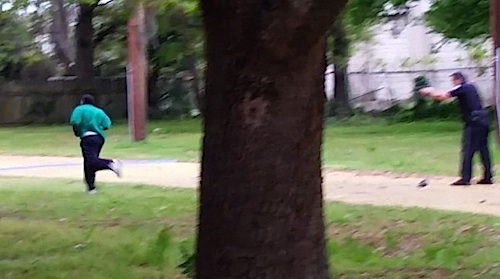 By Earl Ofari Hutchinson, originally published at New America Media.
By Earl Ofari Hutchinson, originally published at New America Media.
Former North Charleston Police officer Michael Thomas Slager has been charged with murder in the shooting death of Walter Scott. At first glance, it seems a virtual slam dunk to nail Slager on the charge.
There’s the clear as a bell video shot in broad daylight which shows Scott in full flight not toward but away from Slager. There’s Slager clearly drilling him as he flees. There’s the unequivocal, even outraged retort by North Charleston police chief Eddie Driggers that he was “sickened” at seeing the video. North Charleston Mayor Keith Summey and Driggers visited the slain man’s family and commiserated with their “suffering.” To top it off, Slager was jailed with no bond immediately set.
But that doesn’t mean that he’ll be convicted of murder, or for that matter any other charge in the Scott killing. The reason for that tells much about the way the over use of deadly force by officers is treated within the criminal justice system. Even in the rare cases, such as Slager where cops are hauled into a court docket for overuse of deadly force, they routinely walk free. Their defense lawyers are top guns, with lots of experience defending police officers accused of misconduct. Police unions bankroll their defense and spare no expense. Slager is the even more rare exception in that he was actually fired and jailed. They are usually placed on administrative (paid) leave pending the start or finish of a pro forma promised investigation. And when they do serve pre-trial jail time, they are quickly released on ridiculously low bail. We’ll watch closely to see what Slager’s bail is set at.
When the cops are tried by a jury, police defense attorneys seek to get as many middle class people, whites and even blacks and Latinos, on the jury as possible. The presumption is that they are much more likely to believe the testimony of police and police defense witnesses than black witnesses, defendants, or even the victims. It’s a presumption that has been born out in police misconduct trials time and again. George Zimmerman even got the benefit of that presumption when he walked in the shooting death of Trayvon Martin.
It’s an uphill battle for prosecutors to overcome both pro-police attitudes and negative racial stereotypes. Stanford University researchers recently found that even when many whites are presented with evidence that the criminal justice system is loaded with racial bias toward blacks they are more likely to support tough, draconian laws such as three strikes, tough sentencing and increased incarceration. Scott is a near textbook example of that problem. Before the video surfaced, the press had a field day, happily playing up Scott’s criminal record. The implication always being that he was a bad guy who got what he deserved and that the officer was the put upon victim that had no choice but to use deadly force.
The negative perceptions of blacks, especially black males, by much of the public are not the only problem in effecting effective legal measures against police violence. There is no ironclad standard of what is or isn’t an acceptable use of force in police misconduct cases. It often comes down to a judgment call by the officer. In the Rodney King beating case in 1992 in which four LAPD officers stood trial, defense attorneys painted King as the aggressor and claimed that the level of force used against him was justified. This pattern has been evident in a number of celebrated cases since then. Police claim that they feared for their lives in confronting civilians and they use deadly force solely in self-defense.
Then there’s the supposedly smoking gun video that will prove beyond a shadow of a doubt that Slager overused deadly force. The King case proved this to be bunkum. The attorneys twisted, turned, dissected, redissected, analyzed and reanalyzed it from every earthly angle. They claimed it didn’t show what led up to the King beating, didn’t fully show King’s resistance, didn’t show the officers giving instructions to him to comply, and was too limited in the angle that it was shot. The jury bought the claim.
This tact has been used repeatedly in other instances where videos and cell phone footage catches a cop committing an abuse against an unarmed non resisting citizen. It’s still a matter of what you see is really not what you see in these cases.
Slager may indeed wind up being the even rarer still case of a cop convicted of murdering in cold-blood an unarmed black man. If past history is any guide, though, just don’t bet on it yet.
Earl Ofari Hutchinson is an author and political analyst. He is a frequent MSNBC contributor. He is an associate editor of New America Media. He is a weekly co-host of the Al Sharpton Show on American Urban Radio Network. He is the host of the weekly Hutchinson Report on KTYM 1460 AM Radio Los Angeles and KPFK-Radio and the Pacifica Network.


